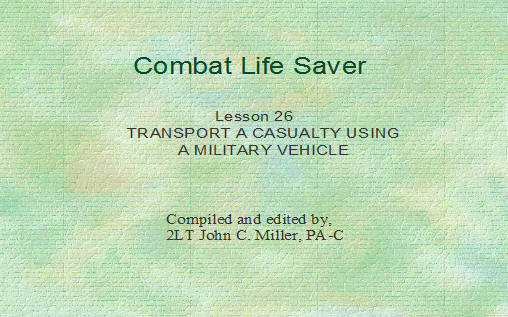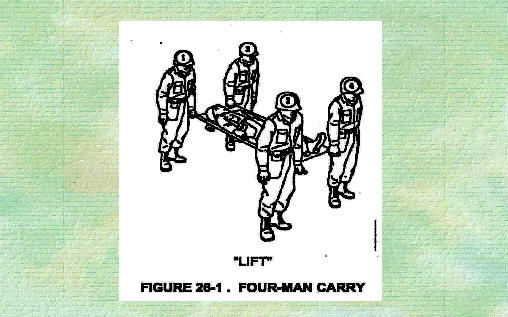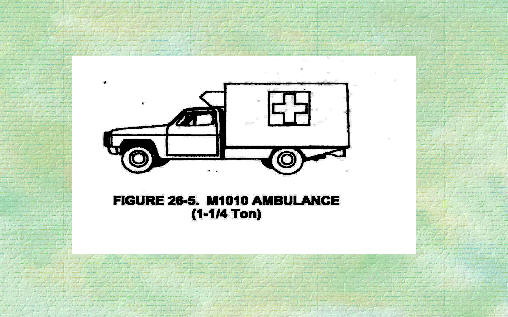Transport a casualty using a military vehicle
Click here to download the presentation.



Lesson 26
TRANSPORT A CASUALTY USING
A MILITARY VEHICLE
INTRODUCTION
When possible, military vehicles are used to evacuate casualties. The vehicle may be a helicopter modified to be an air ambulance or a ground vehicle modified to be a ground ambulance. If these are not available, other military vehicles can be used to carry casualties. As a combat lifesaver, you may need to use tactical military vehicles to transport casualties or assist medical personnel in loading and unloading air and ground ambulances.
TRANSPORT A CASUALTY USING
A MILITARY VEHICLE
TASK
Identify procedures for moving casualties by litter and loading and unloading casualties using military vehicles.
CONDITIONS
Given multiple-choice items pertaining to evacuation.
STANDARD
Score 70 or more points on the 100-point written examination.
DETERMINE THE ORDER IN WHICH
CASUALTIES ARE TO BE EVACUATED
First Priority
Casualties with serious respiratory problems.
Casualties with severe blood loss.
Casualties with second and third degree burns of the face, neck, or perineum.
Casualties with closed head injuries, with decreasing mental status.
Casualties with poor blood circulation in a limb or with no detectable circulation in a limb.
DETERMINE THE ORDER IN WHICH
CASUALTIES ARE TO BE EVACUATED
Second Priority
Casualties with chest wounds.
Casualties with abdominal wounds.
Casualties with extensive, serious eye injury.
Casualties with fractures.
Casualties with serious second and third degree burns not involving the face, neck, or perineum.
DETERMINE THE ORDER IN WHICH
CASUALTIES ARE TO BE EVACUATED
Third Priority
Casualties with injuries which have been stabilized and do not threaten the casualty with loss of life or limb.
Casualties with injuries so severe that only extensive and complicated medical treatment can prolong their life.
MOVE A CASUALTY USING A
FOUR-MAN LITTER SQUAD
Preparing the Litter
Open a standard litter.
Lock the spreader bars at each end of the litterwith your foot.
Preparing the Casualty
Place casualty onto litter using the modified two-man arms carry or the modified two-man fore-and-aft carry.
Secure the casualty to the litter with litter straps.
MOVE A CASUALTY USING A
FOUR-MAN LITTER SQUAD
Preparing the Four-Man Litter Squad
Position one squad member at each litter handle with the litter squad leader at the casualty’s right shoulder.
Question:
Why should the leader be in this position?
Response:
It is the best position for monitoring the casualty’s condition.
MOVE A CASUALTY USING A
FOUR-MAN LITTER SQUAD
If the casualty does not have a fractured leg:
Carry feet first when traveling on level ground or going down.
Carry head first when going up a hill or up stairs.
If the casualty has a fractured leg:
Carry head first when traveling on level ground or going down.
Carry feet first going up a hill or stairs.
Question:
Why would you change the procedures for a casualty with a fractured leg?
Response:
To keep the weight of the casualty’s body from pressing on the fracture.
MOVE A CASUALTY USING A
FOUR-MAN LITTER SQUAD
Lifting the Litter
On the preparatory command, “Prepare to lift,” the four bearers kneel beside and grasp litter handles.
On the command of execution, “LIFT,” all bearers rise together.
On the command, “Four-man carry, MOVE,” all bearers walk forward in unison.
Uphill Carry
Used to go up a hill or stairs.
MOVE A CASUALTY USING A
FOUR-MAN LITTER SQUAD
Downhill Carry
Used to go down a hill or stairs.
MOVE A CASUALTY USING A
FOUR-MAN LITTER SQUAD
Litter Post Carry
Used to keep the litter level in rough terrain.
MOVE A CASUALTY USING A
FOUR-MAN LITTER SQUAD
Litter Rotation
To change direction of movement, such as from feet first to head first, begin in a litter post carry position. The front and back bearers release the litter and the middle bearers rotate the litter and themselves.
LOAD CASUALTIES INTO
GROUND AMBULANCES
General Rules for Using Ground Ambulances
Ground ambulances have medical specialists to take care of the casualties during evacuation.
Follow any special instructions for loading, securing, or unloading casualties.
Make sure each litter casualty is secured to his litter. Use litter straps when available.
Load the most seriously injured casualty last.
LOAD CASUALTIES INTO
GROUND AMBULANCES
Load a casualty head first (head in the direction of travel) rather than feet first.
Make sure each litter is secured to the vehicle.
Unload casualties in the reverse order in which they are loaded.
Question:
When is the most seriously injured litter casualty unloaded?
Response:
First.
LOAD CASUALTIES INTO
GROUND AMBULANCES
M170 1/4-Ton Truck Ambulance (Frontline Ambulance)
Designed to carry:
3 litter casualties, or
5 ambulatory (walking) casualties, or
2 litter casualties and 3 ambulatory casualties (mixed load).
Sequence for loading 3 litter casualties:
Upper right berth.
Lower right berth.
Left berth.
LOAD CASUALTIES INTO
GROUND AMBULANCES
Sequence for loading a mixed load:
Upper right berth.
Lower right berth.
Ambulatory casualties.
LOAD CASUALTIES INTO
GROUND AMBULANCES
M1010 1 1/4-Ton Truck Ambulance
Designed to carry:
4 litter casualties, or
8 ambulatory casualties, or
2 litter casualties and 4 ambulatory casualties (mixed load).
Sequence for loading 4 litter casualties:
Upper right berth.
Lower right berth.
Upper left berth.
Lower left berth.
LOAD CASUALTIES INTO
GROUND AMBULANCES
Sequence for loading a mixed load:
Upper right berth.
Lower right berth.
Ambulatory casualties on left side.
LOAD CASUALTIES INTO
GROUND AMBULANCES
M996 Armored Ambulance (HMMWV)
Designed to carry:
2 litter casualties, or
6 ambulatory casualties, or 1 litter casualty and 3 ambulatory casualties (mixed load).
Sequence for loading 2 litter casualties:
Right berth.
Left berth.
LOAD CASUALTIES INTO
GROUND AMBULANCES
M997 Armored Ambulance (HMMWV)
Designed to carry:
4 litter casualties, or
8 ambulatory casualties, or
2 litter casualties and 4 ambulatory casualties (mixed load).
Sequence for loading 4 litter casualties:
Upper right berth.
Lower right berth.
Upper left berth.
Lower left berth.
LOAD CASUALTIES INTO
GROUND AMBULANCES
Sequence for loading 2 litter casualties:
Upper right berth.
Lower right berth.
Ambulatory casualties on left side.
LOAD CASUALTIES INTO
GROUND AMBULANCES
M792 1 1/4-Ton Truck Ambulance
Designed to carry:
3 litter casualties, or
6 ambulatory casualties, or
2 litter casualties and 3 ambulatory casualties (mixed load).
Sequence for loading 3 litter casualties:
Upper right berth.
Upper left berth.
Lower center berth.
Sequence for loading 2 litter casualties:
Upper berth.
Lower center berth.
Ambulatory casualties on remaining side.
LOAD CASUALTIES INTO
GROUND AMBULANCES
M113 Full-Tracked Armored Personnel Carrier
An M113 armored personnel carrier is transformed into an ambulance by removing the spall liner and installing the litter suspension kit.
Designed to carry:
4 litter casualties, or
10 ambulatory casualties, or 2 litter casualties and 5 ambulatory casualties (mixed load).
Sequence for loading 4 litter casualties:
Upper right berth.
Lower right berth.
Upper left berth.
Lower left berth (most seriously injured casualty).
LOAD CASUALTIES INTO AIR AMBULANCES
Casualties may be evacuated by helicopter, especially if the distance to be traveled is great and the location hard to reach.
LOAD CASUALTIES INTO AIR AMBULANCES
General Rules for Using Air Ambulances
Air ambulances have medical specialists to take care of the casualties during evacuation. Follow any special instructions for loading, securing, or unloading casualties.
Remain 50 yards from the helicopter until the litter squad is signaled to approach the aircraft.
Approach the aircraft from the front so the litter squad is in full view of the pilot. Keep a low silhouette when approaching the aircraft.
LOAD CASUALTIES INTO AIR AMBULANCES
Approach and leave the aircraft quickly, but do not run.
Avoid the area near the rear rotor of the Blackhawk and Iroquois air ambulance helicopters.
If you must go from one side of the helicopter to the other, go around the front of the helicopter.
LOAD CASUALTIES INTO AIR AMBULANCES
WARNING!
NEVER GO AROUND THE REAR OF THE
HELICOPTER AND ALWAYS GO FROM
THE DOWNHILL SIDE.
LOAD CASUALTIES INTO AIR AMBULANCES
Take orders from the combat medic or loadmaster on the aircraft.
Load the most seriously injured casualty last.
Load the casualty which will occupy the upper berth first; then load the next litter casualty immediately under the first casualty. This is done to keep a casualty from accidentally falling on another casualty should his litter drop before it is secured.
LOAD CASUALTIES INTO AIR AMBULANCES
When casualties are placed lengthwise, position them with their heads toward the direction of travel.
Make sure each litter casualty is secured to his litter.
Make sure each litter is secured to the aircraft.
Unload casualties in the reverse order in which they are loaded, unloading the most seriously injured casualty first.
LOAD CASUALTIES INTO AIR AMBULANCES
UH-60A Blackhawk Air Ambulance
The Blackhawk is the primary air ambulance used in combat. There are two methods of configuring a Blackhawk helicopter to serve as an air ambulance.
Normal configuration is designed to carry:
4 litter casualties and one ambulatory casualty, or
7 ambulatory casualties, or
2 litter casualties and 4 ambulatory casualties (mixed load).
LOAD CASUALTIES INTO AIR AMBULANCES
Other configuration is designed to carry:
6 litter casualties and one ambulatory casualty, or
7 ambulatory casualties, or
3 litter casualties and 4 ambulatory casualties (mixed load).
Litter casualties can be loaded on both sides of the helicopter (top to bottom) simultaneously.
LOAD CASUALTIES INTO AIR AMBULANCES
UH-1H/V Iroquois Air Ambulance
Designed to carry:
6 litter casualties, or
9 ambulatory casualties, or
3 litter casualties and 4 ambulatory casualties (mixed load).
LOAD CASUALTIES INTO AIR AMBULANCES
Loading 6 litter casualties:
Load the casualties lengthwise (heads forward toward the direction of travel) with three casualties on each side.
Litter casualties can be loaded on both sides of the helicopter (top to bottom) simultaneously.
LOAD CASUALTIES INTO AIR AMBULANCES
Loading a mixed load:
Load three casualties crosswise (top to bottom) across the back of the compartment.
Seat the ambulatory casualties seated in the forward part of the compartment (two on the right side and two on the left side).
LOAD CASUALTIES INTO AIR AMBULANCES
CH-47 Chinook Air Ambulance
The CH-47 Chinook air ambulance is a dual rotary-wing aircraft.
Designed to carry:
Up to 24 litter casualties, or
31 ambulatory casualties, or
Several combinations of mixed loads.
Litter racks are filled from front to back and from top to bottom. Any ambulatory casualties are usually seated in the front of the compartment.
LOAD CASUALTIES ON
GROUND MILITARY VEHICLES
Nonmedical military vehicles can be used to evacuate casualties when no medical evacuation vehicles are available.
General Rules for Using Tactical Ground Vehicles
If medical personnel are present, follow their instructions for loading, securing, and unloading casualties.
When loading casualties into a vehicle, the most seriously injured casualty is usually loaded last.
LOAD CASUALTIES ON
GROUND MILITARY VEHICLES
When a casualty is placed lengthwise, load him with his head pointing forward toward the direction of travel.
Make sure each litter casualty is secured to his litter. Use litter straps, if available.
Secure each litter to the vehicle as it is loaded into place. Make sure all litters are secured.
Unload casualties in the reverse order in which they are loaded, with the most seriously injured casualty being unloaded first.
LOAD CASUALTIES ON
GROUND MILITARY VEHICLES
M151 1/4-Ton Utility Truck with Trailer
An M151, 4×4, 1/4-ton utility truck, commonly called the jeep, can be used to evacuate two litter casualties. A two-wheeled trailer can be attached to the M151 truck and be used to transport two additional litter casualties.
Place the first litter across the back of the vehicle with the litter handles resting on the sides of the vehicle.
Place the second litter lengthwise on the right side of the vehicle with the rear handles resting on the side of the first litter and the front stirrups (stands) of the litter fitted into the groove below the windshield.
LOAD CASUALTIES ON
GROUND MILITARY VEHICLES
An alternate method is to rest the front handles on the windshield frame and have the rear handles straddle the spare tire.
Place the third and fourth litters lengthwise on the trailer with the casualties’ heads toward the direction of travel. Litters can be loaded simultaneously. Secure the handles of the litters to the small hooks on the side of the trailer with bindings.
LOAD CASUALTIES ON
GROUND MILITARY VEHICLES
M880, M890, or M1008 1 1/4-Ton Cargo Truck
M880, M890, and M1008, 4×4 or 4×2, 1 1/4-ton cargo trucks are light-weight vehicles used to transport personnel or light cargo. They can be adapted to evacuate up to five litter casualties.
To prepare the vehicle for evacuating litter casualties:
Fold the fabric cover and metal bows forward (toward the truck cab) as an assembly and secure the assembly to the front bow.
Lower the tailgate.
Lower the seats and lock them in place.
LOAD CASUALTIES ON
GROUND MILITARY VEHICLES
To load 5 litter casualties:
Load the first litter crosswise across the sideboards close to the truck cab, usually with the casualty’s head behind the driver’s seat.
Load the second litter crosswise across the sideboards next to the first litter, usually with the casualty’s head behind the passenger’s seat (loaded alternately head to foot).
Load the third litter crosswise across the sideboards next to the second litter, usually with the casualty’s head behind the driver’s seat.
Load the fourth litter head first (toward the cab) on the right side of the bed of the truck.
LOAD CASUALTIES ON
GROUND MILITARY VEHICLES
Use the litter stirrups.
Load the fifth litter head first on the left side of the bed of the truck. Use the litter stirrups to keep the litter off the floor.
Raise and fasten the tailgate to secure the lower litters.
LOAD CASUALTIES ON
GROUND MILITARY VEHICLES
2 1/2-Ton or 5-Ton Wide Bed Cargo Truck
The 2 1/2-ton or the 5-ton, 6×6, cargo truck can be used to transport up to 12 litter casualties.
To prepare the truck for evacuating litter casualties:
Roll the canvas top forward toward the truck cab and secure it to the front bow.
Lower the tailgate.
Lower the seats and lock them in place.
LOAD CASUALTIES ON
GROUND MILITARY VEHICLES
Load litter casualties in the following manner:
Load the first group of three litters crosswise across the seats in the front half (near the cab) of the truck with the litter handles resting on the seats. The casualties are usually placed head to foot (head of first casualty behind driver’s side, head of second casualty behind passenger’s side, and head of third casualty behind driver’s side).
Load the second group of three litters lengthwise on the floor in the front half (near the cab) of the truck beneath the first group of litters. Load the casualties head first (head toward the cab). Use the stirrups to keep the litters off the floor.
Load the third group of three litters crosswise across the seats in the rear half of the truck with the litter handles resting on the seats.
LOAD CASUALTIES ON
GROUND MILITARY VEHICLES
Continue to alternate casualties (head of seventh casualty behind passenger’s side, head of eighth casualty behind driver’s side, and head of ninth casualty behind driver’s side).
Load the fourth group of three litters lengthwise on the floor in the rear half of the truck beneath the third group of litters. Load the casualties with their heads toward the cab. Use the stirrups to keep the litters off the floor.
Raise and secure the tailgate as high as possible to help secure the litters in place.
TRANSPORT A CASUALTY USING
A MILITARY VEHICLE
CLOSING
As a combat lifesaver, you will probably be asked to assist the combat medic in evacuating wounded personnel when your combat duties allow. If no combat medic is available, you may need to instruct other soldiers in the procedures for evacuating litter casualties.
This lesson is tested in the written multiple-choice examination.
Questions